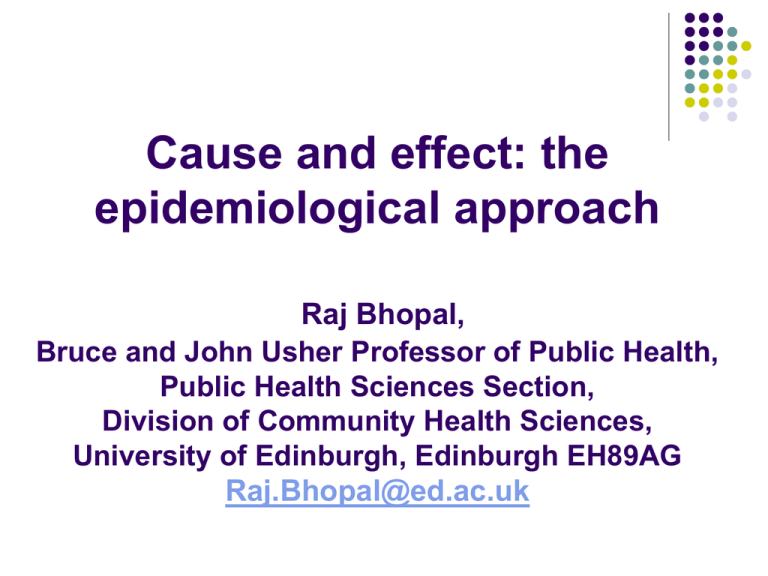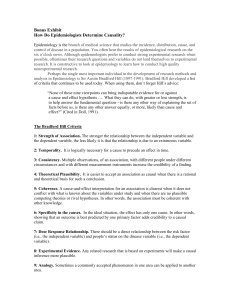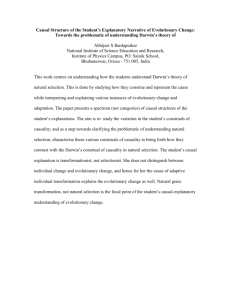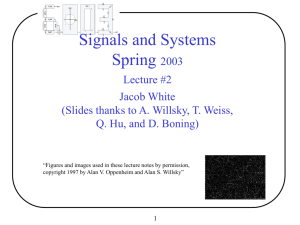Cause and effect
advertisement

Cause and effect: the epidemiological approach Raj Bhopal, Bruce and John Usher Professor of Public Health, Public Health Sciences Section, Division of Community Health Sciences, University of Edinburgh, Edinburgh EH89AG Raj.Bhopal@ed.ac.uk Educational objectives On completion of your studies you should understand: The purpose of studying cause and effect in epidemiology is to generate knowledge to prevent and control disease. That cause and effect understanding is difficult to achieve in epidemiology because of the long natural history of diseases and because of ethical restraints on human experimentation. How causal thinking in epidemiology fits in with other domains of knowledge, both scientific and non-scientific. The potential contributions of various study designs for making contributions to causal knowledge. Cause and effect Cause and effect understanding is the highest form of achievement of scientific knowledge. Causal knowledge permits rational plans and actions to break the links between the factors causing disease, and disease itself. Causal knowledge can help predict the outcome of an intervention and help treat disease. Quote Hippocrates "To know the causes of a disease and to understand the use of the various methods by which the disease may be prevented amounts to the same thing as being able to cure the disease". Epidemiological contributions to cause and effect A philosophy of health and disease. Models which illustrate that philosophy. Frameworks for interpreting and applying the evidence. Study designs to produce evidence. Evidence for cause and effect in the relationships of numerous factors and diseases. Development of the reasoning of other disciplines including philosophy and microbiology, in reaching judgement. A cause? The first and difficult question is, what is a cause? A cause is something which has an effect. In epidemiology a cause can be considered to be something that alters the frequency of disease, health status or associated factors in a population. Pragmatic definition. Philosophers have grappled with the nature of causality for thousands of years. Some philosophy David Hume's philosophy has been influential. A cause cannot be deduced logically from the fact that two events are linked. Because thunder follows lightning does not mean thunder is caused by lightning. Observing this one million times does not make it true. The axiom “Association does not mean causation”. Cause and effect deductions need more than observation alone - they need understanding. The contribution of another philosopher, John Stuart Mill, captured in his canons, is so similar to the modern empirically based ideas of epidemiology. Epidemiological strategy and reasoning: the example of Semelweis Diseases form patterns, which are ever changing. Clues to the causes of disease are inherent within these pattern. Semelweis (1818-1865) observed that the mortality from childbed fever (now known as puerperal fever) was lower in women attending clinic 2 run by midwives than it was in those attending clinic 1 run by doctors. Do these observations spark off any ideas of causation in your mind? Births, deaths, and mortality rates (%) for all patients at the two clinics 1841-1846 First clinic Second clinic Births Deaths Rate Births Deaths Rate 20042 1989 9.92 17791 691 3.38 Semmelweis’ inspiration In 1847, his colleague and friend Professor Kolletschka died following a fingerprick with a knife used to conduct an autopsy. Kolletschka’s autopsy showed inflammation to be widespread, with peritonitis, and meningitis. “Day and night I was haunted by the image of Kolletschka’s disease and was forced to recognise, ever more decisively that the disease from which Kolletschka died was identical to that from which so many maternity patients died.” Semelweis' inspired idea was that particles had been transferred from the scalpel to the vascular system of his friend and that the same particles were killing maternity patients. Semmelweis’ action If so, something stronger than ordinary . needed for handwashing soap was He introduced chlorina liquida, and then for reasons of economy, chlorinated lime. The maternal mortality rate plummeted. Semelweis’s discovery was resented in Vienna. Lessons from Semmelweis’s work Deep knowledge derives from the explanation of disease patterns, rather than in their description. Inspiration is needed, and may come from unexpected sources, as here from Kolletschka’s autopsy. Action cannot always await understanding the mechanism. Epidemiological data to show that laying an infant on its front (prone position) to sleep raises the risk of 'cot death' or sudden infant death syndrome. A campaign to persuade parents to lay their infants on their backs has halved the incidence of cot death. Epidemiologists are reliant on other sciences, laboratory or social, to be equal partners, in pursuit of the mechanisms. Epidemiological principles and models of cause and effect Most important of the cause and effect ideas underpinned by epidemiology is that disease is virtually always a result of the interplay of the environment, the genetic and physical makeup of the individual, and the agent of disease. Diseases attributed to single causes are invariably so by definition. The fact that “tuberculosis” is “caused” by the tubercle bacillus is a matter of definition. The causes of tuberculosis, from an epidemiological or public-health perspective, are many, including malnutrition and overcrowding. This idea is captured by several well known disease causation models, such as the line, triangle, the wheel, and the web. Figure 5.2 Is the disease predominantly genetic or environmental? Clues Clues Stable in incidence Clusters in families Incidence varies rapidly over time or between genetically similar populations Genetic Environmental Figure 5.3 Down’s syndrome Phenylketonuria Sickle cell disease Diabetes Genetic Environmental Asthma Coronary heart disease Stroke Lung cancer Road traffic accidents Figure 5.4 Host The underlying cause of the disease is a result of the interaction of several factors, which can be analysed using Agent Environment the components of the epidemiological triangle. Figure 5.5 Host: Inhalation of infective organism, age, smoking, male sex, cardio-respiratory disease Agent: Virulent Legionella organisms, e.g. pneumophila serotype Environment: Presence of cooling towers and complex hot water systems; aerosols created but not contained, meteorological conditions take aerosol to humans Figure 5.6 Control smoking and causes of immunodeficiency Minimise growth of organisms and factors which enhance pathogenicity, e.g. algae Avoid wet type cooling towers, look for a better design and location, separate towers from population and enhance tower hygiene Figure 5.7 The model Social environment Physical environment emphasises the unity of the gene and host Gene / host within an interactive environmental envelope The overlap between environmental components emphasises the arbitrary distinctions Chemical & biological environment Figure 5.8 Physical environment: availability of health care facilities for diagnosis Gene defect/ enzyme deficiency/ brain damage Chemical & biological environment: diet content Social environment: social support to sustain dietary change Models of cause and effect Agent factors, arguably, receive less attention than they deserve. Characterising the virulence of organisms is difficult. In other diseases conceptualising the cause as an agent is not easy. The concept of the disease agent has been applied to infections but it works well with many non-infectious agents, for example, cigarettes, motor cars, and alcohol. The interaction of the host, agent and environment is rarely understood. The effect of cigarette smoking is substantially greater in poor people than in rich people. Models of cause and effect Each model is a simplification. Move from simple to complex models. The categories of host, agent and environment are arbitrary. The host and agent are, of course, both part of the environment. Environment, in this context, is arbitrarily defined to mean factors external to the host and the agent of disease. The triangle and prevention The epidemiological triangle can be combined with the schema of the levels of prevention to devise a comprehensive framework for thinking about possible preventive actions. Models: the wheel The wheel of causation. Emphasises the unity of the interacting factors. Emphasises the fact that the division of the environment into components is somewhat arbitrary. Model is applied to phenylketonuria, the archetypal genetic disorder. Phenylketonuria is an autosomal single gene disease . An enzyme required to metabolise the dietary amino-acid phenylalanine and turn it into tyrosine, is deficient. The wheel: phenylketonuria Brain damage is the outcome. The cause of this disease could be said to be a gene. The cause of the disease could be considered as a combination of a gene. Exposure to a chemical and biological environment which provides a diet containing a high amount of phenylalanine. A social environment unable to protect the child from the consequences, of a gene disorder. Models: the spider’s web For many disorders our understanding of the causes is highly complex. Either the causes are truly complex, or equally likely, our understanding is too rudimentary to permit clarity. These disorders are referred to as multifactorial or polyfactorial disorders. Mechanisms of causation are not apparent. Portrayed by the metaphor of the spider’s web. This modelindicates the potential for the disease to influence the causes and not just the other way around, so-called, reverse causality. It also poses a fundamental question: Where is the spider that spun the web? Individual exercise on gene/environment interaction Think about a disease that one of your friends or relatives have had...except for those we have discussed! Reflect on the causes using the line, triangle and wheel of causation. At your leisure: Think through the cause of disease X using these models (box 1.6, chapter 1). Is disease X likely to be genetic or environmental? Why? Go over your answers with your classmates Analysing diseases using the wheel and web models Review the health problems or diseases that you picked and disease X (Chapter 1, box 1.6) using the wheel and web models. Necessary and sufficient cause Last's Dictionary tells us that a necessary cause is "A causal factor whose presence is required for the occurrence of the effect” , and, Sufficient cause as a “minimum set of conditions, factors or events needed to produce a given outcome”. The tubercle bacillus is required to cause tuberculosis but, alone, does not always cause it, so it is a necessary, not a sufficient, cause. Consider the causes of Down’s syndrome (Trisomy 21), sickle cell disease, tuberculosis, scurvy, phenylketonuria, and lung cancer. When a specific cause of disease is sufficiently well known it can be incorporated into its definition (as in Down's Syndrome, sickle cell disease and vitamin C deficiency). Rothman’s component causes model Rothman's interacting component causes model has emphasised that the causes of disease comprise a constellation of factors. It has broadened the sufficient cause concept to be a minimal set of conditions which together inevitably produce the disease. The concept is shown in figure 11 Three combinations of factors (ABC, BED, ACE) are shown here as sufficient causes of the disease. Each of the constituents of the causal "pie" are necessary. Control of the disease could be achieved by removing one of the components in each "pie" and if there were a factor common to all "pies" the disease would be eliminated by removing that alone. Figure 5.11 A B C A E D E A C Each of the three components of the interacting constellations of causes (ABC, ADE, ACE) are in themselves sufficient and each is necessary Guidelines for epidemiological reasoning on cause and effect Turning epidemiological data into an understanding of cause and effect is challenging. Epidemiologists need an explicit mode of reasoning. Subjective judgements on cause and effect in epidemiology should not be dismissed. Epidemiologists place much more emphasis on the evaluation of empirical data. Criteria for causality provide a way of reaching judgements on the likelihood of an association being causal. A framework for thought, applied before making a judgement, based on all the evidence. Epidemiological criteria (guidelines) for causality Causal criteria in microbiology, health economics, philosophy offer much to epidemiology. Henle-Koch postulates. Mill’s canons Economics also evaluates associations in similar ways. According to Charemza and Deadman, the operational meaning of causality in economics is more on the lines of 'to predict' than 'to produce' (an effect). Epidemiological criteria are, however, designed for thinking about the causes of disease in Epidemiological thinking in cause and effect Epidemiology establishes causes in populations but this information applies to individuals in a probabilistic way. Which does not prove cause and effect at the individual level . If 90% of all lung cancer in a population is due to smoking, what is the likelihood that in an individual with lung cancer the cause was smoking? There is no way to distinguish a lung cancer resulting from smoking from a lung cancer arising from another cause. A factor demonstrated to cause a disease in an individual, say using toxicology or pathology, may not be demonstrable as harmful in the population. Why? Limitation of a science of individuals. Application of guidelines/criteria to associations An association rarely reflects a causal relationship but it may. These six criteria are a distillation of, or at least, echo the ten Alfred Evans' postulates in Last's Dictionary of Epidemiology (4th edition) and the nine Bradford Hill criteria. Temporality Did the cause precede the effect? If the effect follows the action of a proposed cause the association may be a causal one and the analysis can proceed. Thunder follows lightning. Does lightning cause thunder? If you flick a switch and a light goes on, can you deduce that you and your action cause the light to go on? Just because B follows A, does not of itself, confirm a causal relation. Deeper understanding or opening the black box is essential. Strength and dose response Does exposure to the cause change disease incidence? If not there is no epidemiological basis for a conclusion on cause and effect. Failure to demonstrate this does not, however, disprove a causal role. The usual measure of the increase in incidence is the relative risk and the technical name for this criterion is the strength of the association. Dose-response Does the disease incidence vary with the level of exposure? If yes, the case for causality is advanced. The dose-response relation is also measured using the relative risk. Specificity Is the effect of the supposed cause specific to relevant diseases, and, are diseases caused by a limited number of supposed causes? Imagine a factor which was linked to all health effects Why would that be so? Non-specificity is characteristic of spurious associations eg underestimating the size of the denominator. While specificity is not a critically important criterion epidemiologists should take advantage of the reasoning power it offers. Consistency Is the evidence within and between studies consistent? Consistency is linked to generalisability of findings. Spurious associations are often local. Experiment Does changing exposure to the supposed cause change disease incidence? Often there have been natural experiments. Deliberate experimentation will be necessary. Human experiments or trials are sometimes impossible on ethical grounds. Causal understanding can be greatly advanced by laboratory and experimental observations. Biological plausibility Is there a biological mechanism by which the supposed cause can induce the effect? For truly novel advances, however, the biological plausibility may not be apparent. Biologically plausible that laying an infant on its back to sleep may lead to its inhaling vomitus. Overturned by the biologically implausible observation that laying a child on its back halves the risk of cot death. Nonetheless, biological plausibility remains relevant to establishing causality. Judging the causal basis of the association The criteria are particularly valuable in exposing the lack of evidence for causality, for indicating the need for further research and for avoiding premature conclusions. Sometimes firm judgements are possible. Sometimes, judgments are forced upon us. Three examples of the case for causality in book. Diethylstilboestrol as a cause of adenocarcinoma of the vagina (Herbst et al). Smoking as a cause of lung cancer, (Doll et al) and Residential proximity to a coking works as a cause of ill-health (Bhopal et al). Example of judging causality: lung cancer Question Does the supposed cause precede the disease (effect) Yes, clearly so (temporality) By how much does exposure to the cause raise the incidence of disease? Greatly and as much as 20 to 30 fold in smokers of 20 or more cigarettes per day (strength) Does varying exposure lead to varying disease? Yes, there is clear relationship and more smoking causes more disease (does-response) Does the cause lead to a rise in a few relevant diseases? (specificity) No. Numerous diseases show an association with smoking causality: lung cancer Is the association consistent across different studies and between groups? Yes. The association is demonstrable in men and women, and across social groups. Is the way that the cause exerts its effect on disease understood? Only partly. The tar in cigarettes contains important carcinogens (biological plausibility) Does manipulating the level of exposure to the cause change disease experience? Yes. Reducing consumption of cigarettes reduces risk. Persuading people to smoke more would be unethical. Tobacco is carcinogenic to animals (experimental confirmation) Overall judgement Originally, bitterly contested, now accepted as causal Figure 5.13 The pyramid of associations 1 Causal and mechanisms understood 2 Causal 3 Non-causal 4 Confounded 5 Spurious / artefact 6 Chance Interpretation of data, study design and causal criteria Causal knowledge is born in the imagination and understanding of the disease process of the investigator. Same data can be interpreted in quite different ways. The paradigm within which epidemiologists work will determine the nature of the causal links they see and emphasise. Researchers to make explicit in their writings their guiding research philosophy. No epidemiological design confirms causality and no design is incapable of adding important evidence. Figure 5.12 The scales of causal judgement Weigh up weaknesses in data and alternative explanations Weigh up quality of science and results of applying causal frameworks Epidemiological theory illustrated by this chapter Diseases arise from a complex interaction of genetic and environmental factors. Causes of disease in individuals may not necessarily be demonstrable causes of disease in populations and vice versa. Cause and effect judgements are achievable through hypothesis generation and testing, with data interpreted using a logical framework of analysis. Summary Cause and effect understanding is the highest form of scientific knowledge. Epidemiological and other forms of causal thinking shows similarity. An association between disease and the postulated causal factors lies at the core of epidemiology. Demonstrating causality is difficult because of the complexity and long natural history of many human diseases and because of ethical restraints on human experimentation. Summary All judgements of cause and effect are tentative. Be alert for error, the play of chance and bias. Causal models broaden causal perspectives. Apply criteria for causality as an aid to thinking. Look for corroboration of causality from other scientific frameworks.





